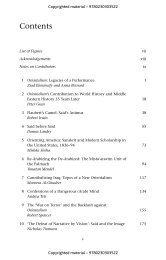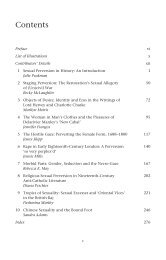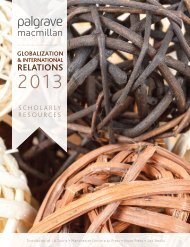The Nameless Shamelessness of Ulysses - Palgrave
The Nameless Shamelessness of Ulysses - Palgrave
The Nameless Shamelessness of Ulysses - Palgrave
Create successful ePaper yourself
Turn your PDF publications into a flip-book with our unique Google optimized e-Paper software.
<strong>The</strong> ‘nameless shamelessness’ <strong>of</strong> <strong>Ulysses</strong> 29<br />
began to prepare their own editions that would compete with this ‘corrected’<br />
text while creating an array <strong>of</strong> slightly different editions. With the passage<br />
<strong>of</strong> the Sonny Bono Copyright Term Extension Act in 1998, however, the<br />
copyright on <strong>Ulysses</strong> was extended for an additional twenty years and the<br />
furore over the accuracy <strong>of</strong> the Gabler edition gave way to a series <strong>of</strong> legal<br />
arguments that again placed the novel between the competing rationalities<br />
<strong>of</strong> art and the law. <strong>The</strong> debate now turned on the rights <strong>of</strong> the Joyce Estate<br />
to control the text and its various adaptations as well as the exact legal status<br />
<strong>of</strong> the original 1922 edition. 8<br />
This scandal may not have the sexual piquancy which accompanied the<br />
book’s original publication, but it has once again provoked a confrontation<br />
between morality and art – in this case between the rights <strong>of</strong> the Joyce<br />
Estate to its intellectual property and the demand from artists and scholars<br />
that it be allowed to circulate freely. Legal sanctions defining intellectual<br />
property rights as well as obscenity serve both to delimit and define what<br />
Bourdieu calls art’s ‘conquest <strong>of</strong> autonomy’, powerfully shaping the otherwise<br />
seemingly autonomous field <strong>of</strong> cultural production. 9 Just as Mullin<br />
cogently reveals the ways in which Joyce anticipated and even exploited his<br />
encounter with the censors while crafting <strong>Ulysses</strong>, so too Paul Saint-Amour<br />
contends that Joyce actively engaged many <strong>of</strong> the debates about copyright<br />
which have more recently mired his text in scandal. 10 <strong>The</strong>se critics reveal the<br />
multiform ways in which Joyce manoeuvered his book into the gap between<br />
the aesthetic and legal fields, deliberately staging their creative confrontation<br />
in order to map the limits <strong>of</strong> his own creative freedom. <strong>The</strong> scandal<br />
<strong>of</strong> <strong>Ulysses</strong> thus continues to lie in its potent ability to provoke this jarring<br />
encounter and thereby reverse or at least retard the autonomization <strong>of</strong> social<br />
life within modernity.<br />
<strong>The</strong> debates about both obscenity and copyright have largely restricted<br />
our focus, however, to the limitations <strong>of</strong> censorship – the ability <strong>of</strong> the law,<br />
that is, to repress or prohibit the circulation <strong>of</strong> a particular text. Too narrow<br />
a focus on the explicit legal mechanisms <strong>of</strong> censorship, however, not only<br />
preserves the liberal image <strong>of</strong> <strong>Ulysses</strong> as an icon <strong>of</strong> free expression but also<br />
deflects attention from the complex ways in which the text struggles with<br />
the far more subtle mechanisms <strong>of</strong> repression structuring the aesthetic field.<br />
In this chapter I want to argue that there remains, in fact, one additional<br />
scandal, largely overlooked, which shapes <strong>Ulysses</strong> even more pr<strong>of</strong>oundly<br />
than either sexuality or intellectual property. It pervades the book from its<br />
opening to its closing pages and has troubled generations <strong>of</strong> critics, who have<br />
developed tortuous intellectual arguments in order to evade its most troubling<br />
implications. Hugh Kenner alludes to it glancingly, describing Joyce’s<br />
decision to abandon the convention <strong>of</strong> the initialled dash when writing<br />
about real people and events, a practice that dates back to the very rise <strong>of</strong> the<br />
novel. ‘In the year 19—, in the city <strong>of</strong> D—’, Kenner writes, ‘that would have<br />
been the decorous way to go about it.’ 11 As Kenner notes, in fact, the French
















